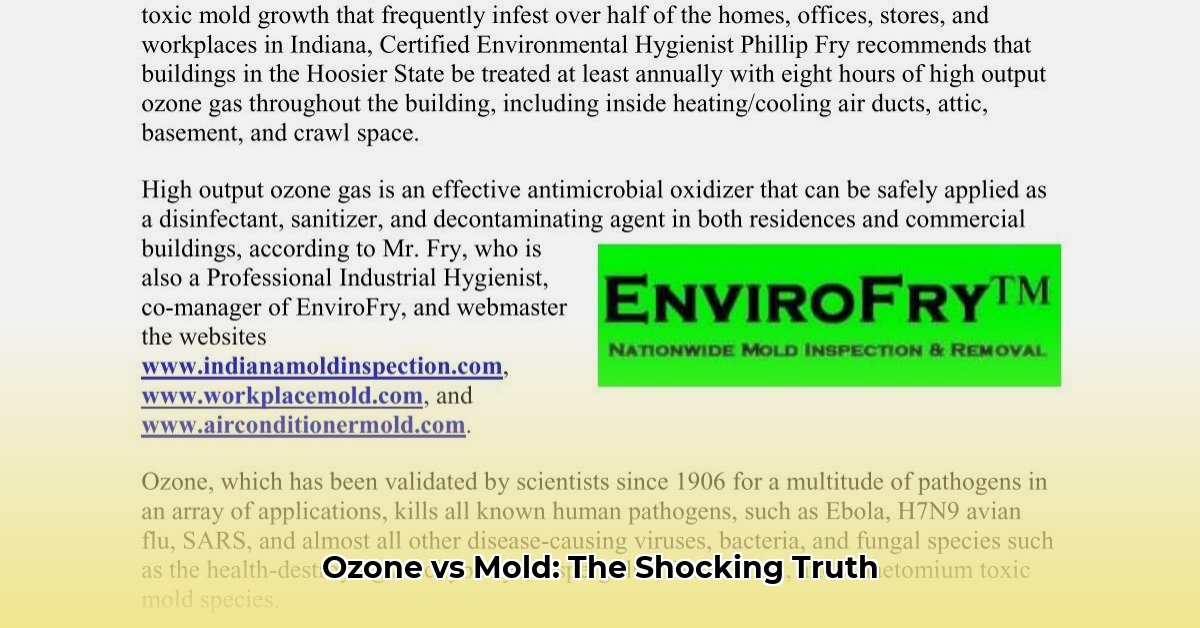Mold in your home is a frustrating problem, and finding a quick fix is tempting. Ozone treatment is often suggested, but is it effective and safe? This guide provides the facts about ozone and mold. We’ll explain why it’s often not the best solution and offer safer, more effective ways to address mold, whether it’s a minor spot or a larger issue. Learn what works and what professionals recommend to eliminate mold and prevent its return. For alternative cleaning solutions, check out this guide on alcohol and mold.
Ozone and Mold Removal: Understanding the Truth
Dealing with mold is unpleasant due to its appearance, odor, and potential health effects. Ozone generators are sometimes promoted as a quick solution, but it’s important to understand the facts before using one. Ozone isn’t the mold-removal superhero it’s often portrayed to be.
The Power of Ozone: Use Cases and Limitations for Mold Control
Ozone is a powerful oxidizer, similar to a super-charged bleach. It’s effective at breaking down substances, but it also poses risks. While ozone can break down some airborne mold spores, its mold-fighting capabilities are limited. It won’t eliminate mold embedded in walls, carpets, or other porous materials. The EPA advises against using ozone generators in occupied spaces due to the risk of lung damage, breathing problems, and worsened asthma.
Does Ozone Really Work for Mold? Assessing the Realities
The notion that ozone completely eradicates mold growing inside walls or in carpets is false. While it slightly improves surface mold and airborne spores, that’s the extent of its effectiveness. Odor improvement might be noticed temporarily, but this only masks the underlying issue, as the mold remains. Using an ozone generator is like applying a bandage to a broken leg; it offers temporary relief but doesn’t address the root cause. It might even worsen the problem by exposing you to harmful ozone. According to the EPA, prolonged exposure to ozone, even at low concentrations, can result in difficulty in breathing, chest pain, and throat irritation. Moreover, ozone can react with other chemicals in your home, creating additional harmful byproducts
A Comprehensive Strategy: Effective Mold Remediation
Effective mold remediation is a process requiring a systematic approach focused on prevention and proper removal, not a single treatment. This strategy focuses on eliminating mold and preventing its return while ensuring the safety of your home and family.
Core Insights:
- Ozone effectively eliminates airborne mold spores and reduces odors, but its impact on surface and embedded mold is limited.
- Prioritize moisture control and physical removal of mold for effective and safe mold removal.
- High concentrations of ozone needed to kill mold are incredibly harmful to your health.
Step 1: Eliminating Mold’s Moisture Source
Mold thrives in damp environments. Battling mold often means battling persistent dampness. This step is vital for stopping mold growth and spread.
- Find and Fix Leaks: Inspect your home for plumbing, roof, and window leaks. Pay close attention to areas around pipes, vents, and chimneys. Repair them promptly to deprive mold of its water source.
- Improve Ventilation: Ensure bathrooms and kitchens have adequate ventilation by using exhaust fans during and after showers and cooking. Open windows when weather permits to promote air circulation and reduce humidity.
- Dehumidify: Use dehumidifiers, especially in basements and bathrooms, to maintain humidity below 50%. Regularly empty and clean dehumidifiers to prevent them from becoming mold sources. Proper humidity control prevents mold from thriving in your home.
- Address Condensation: Insulate cold surfaces to prevent condensation, which provides a perfect environment for mold growth. Consider using vapor barriers in crawl spaces and basements.
Step 2: Proper Mold Removal Techniques
After addressing the moisture, it’s time to remove the visible mold carefully. Choosing the right removal method ensures effective eradication and prevents further contamination.
- Small Infestations: For small isolated areas (less than 10 square feet), carefully remove moldy materials yourself, wearing an N95 or P100 respirator mask, gloves, and eye protection. Isolate the area with plastic sheeting and tape to prevent spores from spreading. Dispose of contaminated materials according to local regulations, usually in sealed plastic bags.
- EPA Registered Cleaners: Use EPA-registered cleaners specifically designed for mold removal, following the instructions for safe and effective cleaning. Avoid using bleach alone, as it can damage some surfaces and may not kill mold spores effectively on porous materials. Always test cleaners in a small, inconspicuous area first.
- Large Infestations: Consult professionals for significant mold problems (larger than 10 square feet) or if mold is present in HVAC systems. They have the expertise, protective gear, and disposal methods for safe and effective handling, achieving a high success rate.
- Cleaning Non-Porous Surfaces: For non-porous surfaces like tiles or bathtubs, scrub with a stiff brush using a mixture of water and a mold-killing cleaner. Rinse thoroughly and dry the area completely.
Step 3: Ongoing Prevention Measures
Cleaning up the mold is not the end. Long-term prevention is key to keeping your home mold-free.
- Maintain Low Humidity: Keep humidity below 50% to deter mold growth. Use a hygrometer to monitor humidity levels and adjust dehumidifiers accordingly.
- Regular Inspections: Check for water leaks, mold signs, or water damage regularly, especially in areas prone to moisture, such as bathrooms, kitchens, and basements.
- Regular Cleaning: Clean and disinfect moisture-prone areas like bathrooms and kitchens regularly to prevent mold spores from settling and growing. Pay special attention to grout, caulk, and shower curtains.
- Proper Airflow: Ensure good airflow throughout your home by opening windows regularly and using fans to circulate air. Avoid overcrowding rooms with furniture that can block airflow.
- Prompt Action: Address any water damage or spills immediately. The faster you dry affected areas, the less chance mold has to grow.
When to Seek Professional Help for Mold Remediation
There’s no shame in seeking professional help. Mold remediation experts are valuable for large infestations, hidden mold (behind walls or in HVAC systems), or mold in hard-to-reach areas. They offer specialized knowledge, equipment, safety protocols, and can identify the root cause of the mold problem, preventing its return. Look for certified mold remediation specialists with experience and proper licensing.
Comparing Available Mold Remediation Options
| Method | Effectiveness | Safety | Cost | Notes |
|---|---|---|---|---|
| Ozone Generators | Low | Very Low | Low-Medium | Dangerous to use in occupied spaces; ineffective for deep-seated mold. May create harmful byproducts. |
| Bleach | Moderate | Moderate | Low | Can damage some surfaces; needs careful handling; may not kill spores on porous materials. |
| Hydrogen Peroxide | Moderate | High | Low | Relatively safe; effective on many surfaces; may require multiple applications. |
| Vinegar | Low | High | Very Low | Best for small, superficial mold problems; may not be as effective as other solutions. |
| Professional Mold Remediation | High | High | High | Most effective, especially for large or hidden mold infestations; ensures proper containment and disposal. |
| HEPA Vacuuming | Moderate | High | Low-Medium | Effective for removing surface mold and spores; must use a HEPA-filtered vacuum to prevent spreading spores. |
Prevention is key. Regular maintenance and quick action are your best defenses against mold. While ozone has limited effects on airborne mold, it’s neither safe nor practical for most homeowners. The risks outweigh the minimal benefits. Focus on moisture control and proper mold removal techniques for a healthy home.
Safely Removing Mold from Porous Building Materials
Key Points:
- Ozone generators aren’t a reliable solution for mold in porous materials, primarily affecting airborne spores.
- Addressing moisture is essential for preventing mold growth.
- Safe mold removal combines moisture control, physical removal, and professional remediation.
Understanding Ozone Limitations in Mold Treatment
Many consider ozone generators a simple mold solution. However, ozone can kill airborne mold spores, but is less effective against mold embedded within drywall or wood. Plus, it can damage sensitive materials like rubber, plastic, and electrical wiring. Getting rid of mold requires tackling the root of the problem.
Ozone treatment has safety risks. High concentrations, required for effective mold removal, can irritate lungs and eyes, especially in sensitive individuals. Ozone can react with materials in your home, creating harmful byproducts, such as formaldehyde. The EPA advises against using ozone generators for mold remediation indoors.
Effective Mold Removal Strategies
So, how do you safely remove mold from porous building materials? A multi-pronged approach is key:
- Moisture Control: The most important step. Fix leaks, improve ventilation, and reduce humidity to prevent future mold growth. Regularly inspect plumbing, roofs, and foundations for potential sources of moisture.
- Identify and Assess: Inspect affected areas. For small mold colonies (less than 10 square feet), you can clean them yourself. Areas larger than 10 square feet require professional help. Be sure to wear appropriate safety equipment.
- Physical Removal: Remove moldy materials carefully with a HEPA-filtered vacuum and dispose of them properly in sealed plastic bags. Clean the area with a mold-killing solution and allow
- Why an App Appeared on My Phone Unexpectedly - November 22, 2025
- How to Stop Unwanted Apps from Automatically Downloading on Android - November 21, 2025
- Why Are Android Games Installing Themselves on Your Phone? - November 20, 2025










